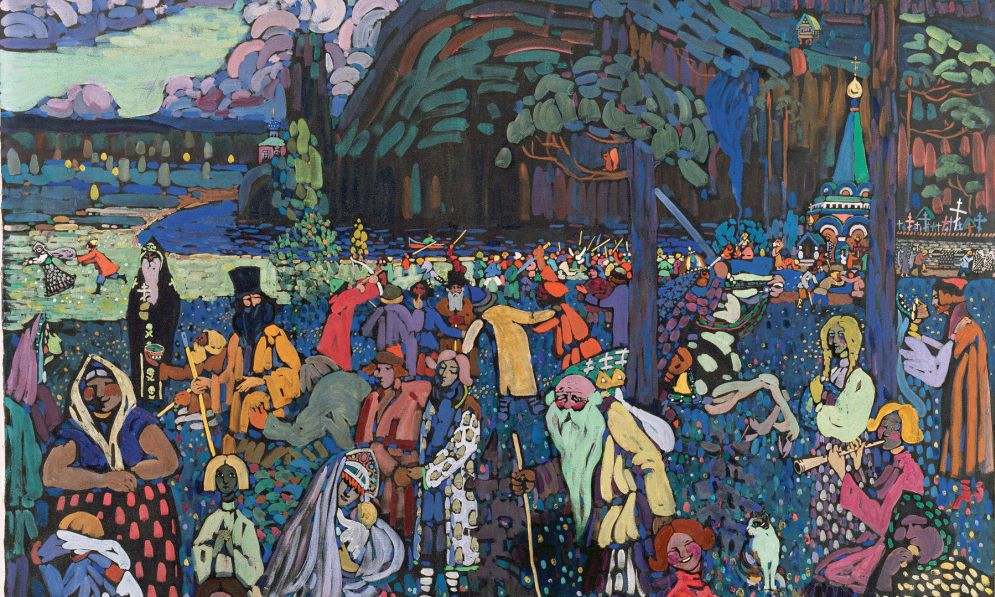A Colorful Life (1907) by Wassily Kandinsky Lenbachhaus, via Wikimedia Commons
After years of legal battles, a German commission recommended this week that a Wassily Kandinsky painting in the possession of a bank owned by the state of Bavaria be restituted to the descendents of the Jewish family who owned the painting before the Second World War.
Wassily Kandinsky’s A Colorful Life (1907) once belonged to Dutch art collector Emanuel Lewenstein, a Jewish director of a large sewing machine factory. Lewenstein and his wife Hedwig owned a large art collection and acquired A Colorful Life in 1927. In 1933, after Lewensetin’s death, his wife loaned the painting to the Stedelijk Museum in Amsterdam. Both of the Lewensteins died in the 1930s and their two children fled the Netherlands shortly before Nazi Germany invaded in 1940.
That same year, the painting was handed over by the Stedelijk Museum and sold in an Amsterdam auction. Bayerische Landesbank, which is largely owned by the government of Bavaria, purchased the painting in 1972. Since then, A Colorful Life has been loaned out to the Städtische Galerie in Munich.
Germany’s Advisory Commission, which deliberates on restitution cases of property seized as a result of Nazi persecution, said Tuesday the painting should be restituted to three descendents of the Lewensteins' children, who jointly sued Bayerische Landesbank in New York in 2017. They claimed A Colorful Life was sold without the permission of their relatives and that the painting rightly belonged to them. That year, the claimants said the painting had an estimated value of $80m. Kandinsky’s record at auction is £37m, set last March when Murnau With Church II (1910) sold at Sotheby’s London. That semi-abstract cityscape was the subject of a 12-year restitution battle before it came to auction.
Bayerische Landesbank suggested A Colorful Life could have been voluntarily auctioned by the first wife of Lewenstein's son during divorce proceedings, and that it would be impossible to determine whether Jewish people’s assets were seized so early during the Nazi occupation of the Netherlands. The bank also said that the Lewenstein family didn’t file a claim for restitution immediately after the war, suggesting the sale was on a voluntary basis.
While the commission could not conclusively determine who arranged the auction of the Lewenstein’s estate in the 1940 auction, it said in its report “there are numerous indications that this was a case of a seizure as a result of Nazi persecution”.
While the commission’s decision is not legally binding, the bank’s largest shareholder, the state government of Bavaria, indicated to the Lewenstein family heirs in 2017 that the Bayerische Landesbank will "unreservedly accept" the decision of the commission, according to Mondex Corporation, a Canadian company that works with families to reclaim looted art and represented the Lewenstein heirs. Bayerische Landesbank did not immediately respond to a request for comment. The family has expressed an interest in lending the painting to another museum, Mondex founder James Palmer says.
Mondex previously worked with the Lewenstein heirs on the restitution of another Kandinsky work, Painting With Houses (1909), which was sold at the same 1940 Amsterdam auction as A Colorful Life. The city of Amsterdam returned that painting, which had also been hanging in the Stedelijk Museum, after a drawn-out legal dispute.
"Restitution is important in so many ways,” Palmer says. “It gives a solution that offers people that suffered a sense of dignity and hope, and justice. They're very important to the claimants, and I think they're in the long-term interest of possessors."
The Lewensteins had around 100 paintings looted from them during the war that Mondex is working to track down, Palmer says.

